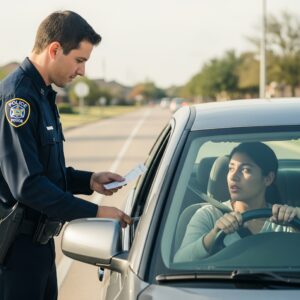Last Updated on June 26, 2025 by Beltz Law Group

Traffic Ticket Defense Attorney in North Texas
Texas traffic laws, particularly those concerning traffic signals, can be intricate and confusing for the average driver. The Texas Transportation Code is indeed a lengthy and comprehensive document, and understanding its nuances is crucial if you’ve received a citation. This updated article aims to demystify the law pertaining to traffic control signals in Texas.
If you’ve been charged with a traffic control signal violation in the Dallas, Texas area and would like to discuss your case with our experienced Dallas ticket attorneys after reading this article, please feel free to contact us at 214-321-4105.
Traffic Control Signal Laws in Texas
The fundamental rules for obeying traffic control signals in Texas are primarily found in Texas Transportation Code Section 544.007, titled “Traffic-Control Signals in General.” This section dictates how drivers must react to different colored lights and arrows.
(a) A traffic-control signal displaying different colored lights or colored lighted arrows successively or in combination may display only green, yellow, or red and applies to operators of vehicles as provided by this section. This sets the basic standard: traffic signals will only display green, yellow, or red lights or arrows.
(b) An operator of a vehicle facing a circular green signal may proceed straight or turn right or left unless a sign prohibits the turn. The operator shall, while the signal is exhibited: (1) yield the right-of-way to other vehicles lawfully in the intersection when the signal is exhibited; and (2) stop and yield the right-of-way to pedestrians lawfully in the intersection or an adjacent crosswalk. This clarifies that a circular green light allows you to proceed straight, turn right, or turn left, unless a sign explicitly prohibits a turn. Critically, even with a green light, drivers must yield to vehicles already in the intersection and to pedestrians in the crosswalk.
(c) An operator of a vehicle facing a green arrow signal, displayed alone or with another signal, may cautiously enter the intersection to move in the direction permitted by the arrow or other indication shown simultaneously. The operator shall stop and yield the right-of-way to a pedestrian lawfully in an adjacent crosswalk and shall yield the right-of-way to other traffic lawfully using the intersection. A green arrow grants

North Texas Traffic Ticket Defense Attorney
permission to proceed in the indicated direction, even if other traffic is stopped. However, the requirement to yield to pedestrians in the crosswalk and other traffic lawfully in the intersection still applies. Note the addition of “stop and” before “yield the right-of-way to a pedestrian” in subsection (c) compared to earlier versions, emphasizing pedestrian safety.
(d) An operator of a vehicle facing only a steady red signal shall stop at a clearly marked stop line. In the absence of a stop line, the operator shall stop before entering the crosswalk on the near side of the intersection. A vehicle that is not turning shall remain standing until an indication to proceed is shown. After stopping, standing until the intersection may be entered safely, and yielding right-of-way to pedestrians lawfully in an adjacent crosswalk and other traffic lawfully using the intersection, the operator may: (1) turn right; or (2) turn left, if the intersecting streets are both one-way streets and a left turn is permissible. This subsection outlines the rules for a steady red light. The primary rule is to stop at the stop line or before the crosswalk. You must remain stopped until a green signal is displayed, with two exceptions:
- Right on Red: After a complete stop, you may turn right on a red light unless a sign prohibits it, and you yield to pedestrians and other traffic.
- Left on Red (One-Way to One-Way): After a complete stop, you may turn left on a red light only if both the street you are on and the intersecting street are one-way streets, and the turn is permissible and made safely after yielding.
(e) An operator of a vehicle facing a steady yellow signal is warned by that signal that: (1) movement authorized by a green signal is being terminated; or (2) a red signal is to be given. A yellow light is a warning that the signal is about to change to red. It is not an authorization to speed up to “beat the light.” You should proceed through the intersection if you are too close to stop safely, but if you can stop safely, you should do so.
(f) The Texas Transportation Commission, a municipal authority, or the commissioners court of a county may prohibit within the entity’s jurisdiction a turn by an operator of a vehicle facing a steady red signal by posting notice at the intersection that the turn is prohibited. This subsection confirms that specific intersections can have “No Turn on Red” signs, overriding the general permission to turn right (or left in the one-way scenario) on red.

Traffic Ticket Defense in North Texas
(g) This section applies to an official traffic-control signal placed and maintained at a place other than an intersection, except for a provision that by its nature cannot apply. A required stop shall be made at a sign or marking on the pavement indicating where the stop shall be made. In the absence of such a sign or marking, the stop shall be made at the signal. This extends the applicability of these rules to signals not located at intersections, such as those controlling access to driveways or specific lanes.
(h) The obligations imposed by this section apply to an operator of a streetcar in the same manner they apply to the operator of a vehicle. This clarifies that streetcar operators are held to the same standards as other vehicle operators regarding traffic signals.
(i) An operator of a vehicle facing a traffic-control signal, other than a freeway entrance ramp control signal or a pedestrian hybrid beacon, that does not display an indication in any of the signal heads shall stop as provided by Section 544.010 as if the intersection had a stop sign. This is a critical provision addressing malfunctioning traffic signals. If a signal is completely dark or otherwise not displaying any indication (and it’s not a freeway ramp control or pedestrian hybrid beacon), drivers must treat it as a four-way stop, stopping before the intersection and yielding to other traffic as if there were stop signs.
(j) In this section: (1) “Freeway entrance ramp control signal” means a traffic-control signal that controls the flow of traffic entering a freeway. (2) “Pedestrian hybrid beacon” means a pedestrian-controlled traffic-control signal that displays different colored lights successively only when activated by a pedestrian. These definitions clarify specific types of signals that have their own operational rules and are exceptions to the general “dark signal” rule in subsection (i).
Importance of Understanding the Law
Traffic signal violations are among the most common citations, but they can carry significant consequences beyond just a fine. These include:
- Points on your driving record: Which can lead to increased insurance premiums.
- Driver Responsibility Program Surcharges: For accumulating too many points.
- Potential driver’s license suspension.
- Impact on professional licenses or employment.

North Texas Ticket Defense Lawyer
How a Dallas Traffic Ticket Lawyer Can Help
Navigating the Texas Transportation Code can be challenging, especially when trying to understand the nuances of traffic signal laws and identify potential defenses. An experienced Dallas ticket attorney can provide invaluable assistance by:
- Explaining the specific charges: Helping you understand precisely what part of the law you are accused of violating.
- Investigating the circumstances: Examining factors like the visibility of the signal, the timing, and any potential malfunctions that could serve as a defense.
- Negotiating with the court: Seeking options like deferred disposition or defensive driving courses to keep the violation off your record.
- Representing you in court: If necessary, an attorney can argue your case, cross-examine witnesses, and work to achieve a dismissal or favorable outcome.
Don’t face a traffic control signal violation alone. Understanding the law and having proper legal representation can make a significant difference in protecting your driving record and avoiding long-term consequences. If you have questions about a traffic ticket in the Dallas area, contact our office today at 214-321-4105 for a consultation.




